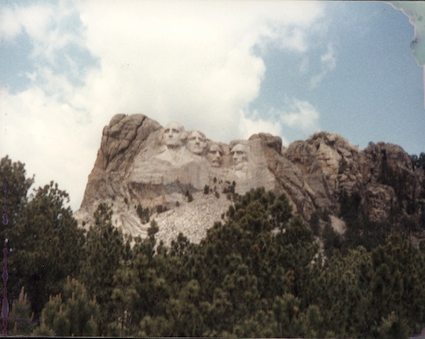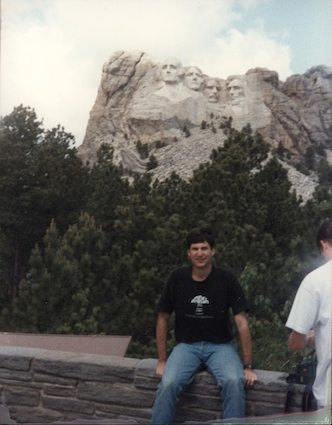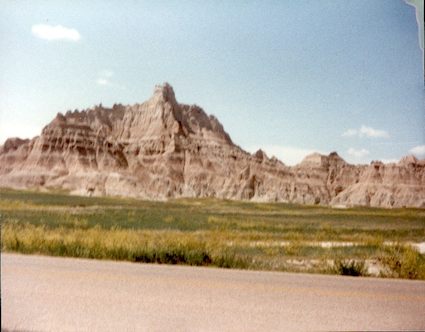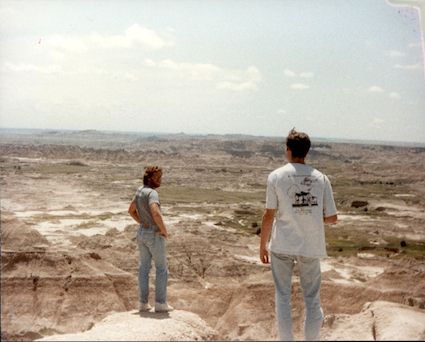Adventures Along Interstate 90 (June 1992)
We had already completed most of our RV tour of the southwestern and interior western National Parks, and we pushed into the final stretch. We still had some time to catch a few more sites as we sped towards our home and the end of our expedition. The entirety of South Dakota loomed ahead of us.
One might be tempted to dismiss South Dakota as nothing more than empty miles situated between the majestic parks of the west and the journey home, but to do so would be an injustice. This would mean missing the immense empty beauty of the Great Plains, that endless expanse of prairie and steppe cutting through the nation’s interior. We focused first on Mount Rushmore, the most popular tourist attraction in a state where tourism is the second largest industry. This spot is hugely important to the state, not only appearing on its vehicle license plate but on its tourist motto: “Great Faces, Great Places.”
Six Grandfathers or Four Presidents?

Mount Rushmore (map) had been known as the Six Grandfathers to the Lakota Sioux who were pushed out of the area in probable violation of the 1868 Treaty of Fort Laramie, not that it mattered to the new claimants. The mountain then obtained its modern name in honor of a Charles E. Rushmore, a New York attorney who happened to be traveling through the Black Hills checking land titles on behalf of a mining company.
Gutzon Borglum later selected this granite wall to sculpt a masterpiece in monumental fashion, bringing everlasting fame to the area. Borglum and four hundred men went to work in 1927 and kept blasting and chiseling that stone until 1941, when the sixty foot images of George Washington, Thomas Jefferson, Theodore Roosevelt and Abraham Lincoln all finally emerged from the outcrop. It was intended as a means to attract visitors to South Dakota and it succeeded. It now serves as the centerpiece of Mount Rushmore National Memorial.
Mount Rushmore

I recall feeling somewhat underwhelmed, not dissimilar to my visits to the Alamo in San Antonio, Texas. In both instances it was difficult for the reality of the situation to match the mythos instilled in someone who grew up within this shared national culture. It’s tough for a celebrated icon to live up to a supersized expectation.
Compounding that, we’d just traveled through some of the most famous and visually stimulating national parks in rapid succession. How could a “mere” carving be expected to stand up to the visual dynamics of the Grand Canyon, Yellowstone or Arches? I expected something, well, BIGGER, more dynamic.
The renowned sculpture on the mountainside loomed a far distance from the public observation deck, further diminishing its awesome actual size and scale and masking the massive effort required to create it. I believe I would have formed a different first impression had we undertaken our journey in a counterclockwise path. Mount Rushmore would have then been one of our first stops rather than one of the last.
Someday I hope to return to this place, now that I have a many more years of life experience to my credit. I think I would be better able to appreciate the effort, beauty and patriotism that lead to its creation.
UPDATE: I did return in 2015 and my earlier prediction came true. I did appreciate it more the second time around.
Into the Badlands

Onward we drove, a little further down that highway to Badlands National Park. Its unusual name derived primarily from early explorers and settlers of European descent who found it difficult to cross because of the rugged landscape. It didn’t hold much promise to farmers either because of inadequate rainfall. Thus they called it “badlands” as if it were worthless, thinking more in economic terms rather than appreciating the immense natural beauty in its own right.
Once an ancient sea covered the entire area. Rivers and floodplains left behind thick deposits atop the layer. In more recent times, geologically speaking, the story has been all about erosion. The deposits have washed away about an inch per year to create the impressive buttes, spires and escarpments found in the park today (map). Someday it will erode away completely but not for many more lifetimes. Those colorful eroding bands also contain some of the richest fossil grounds in the world, a veritable treasure trove of scientific discoveries hidden in those hills.
A World of Transitions

The park represented a transition from where we’d come further west to the flatter terrain of the Great Plains. Badlands National Park has elements of both. In addition to its impressive landforms, it also harbors one of the largest remaining mixed-grass prairies in the nation. It protects rare animals that were once common throughout the plains, including wild bison and black-footed ferrets (only recently reintroduced back into the wild).
The jagged landforms, the beauty of the prairie, the rich deposits of fossils and the endangered wildlife are all good reasons to put the Badlands — in spite of its unattractive name — on any travel itinerary.
A Wonderful Palace of Corn

One of our crew said we simply had to stop at the Corn Palace in the town of Mitchell, right along Interstate 90 towards the eastern side of South Dakota. None of the rest of us had any idea what this was all about, but we took his word for it and we decided to stop. Inside, well, it’s just a space for performances and sporting events, but the exterior was completely different from anything I’d seen. We were greeted by an amazing site, a large auditorium festooned with Moorish domes and minarets, and decorated by artwork cobbled from ears of corn in various shades.
South Dakota and corn go together. A “palace” dedicated to this important crop shouldn’t come as too much of a surprise, and this love affair extended a long way back in the State’s history. It started with the construction of the original Corn Palace for the “Corn Belt Exposition” of 1892. The structure standing in Mitchell today dated to 1921 and it’s the third incarnation. However, the Moorish Revival architecture didn’t arrive until 1937. The corn facade has always been there though, and it takes more than 275,000 ears to create artwork that lasts a single season, only to be torn down and redesigned the following year. Local artists create the designs based upon a theme selected by the Corn Palace Festival Committee.
Our visit took place in 1992, a full one hundred years from that very first Corn Belt Exposition, a fact commemorated in the artwork that year. I’d probably stop by again if ever happen to drive down that stretch of highway. It’s an easy detour and an interesting sight.

Leave a Reply